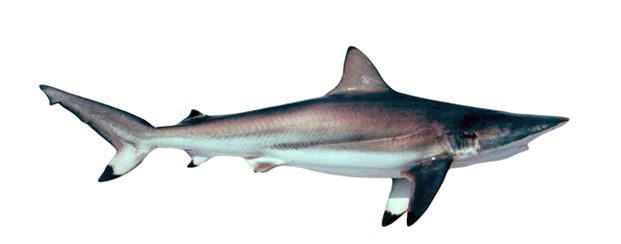Shark, Spinner

View Regulations

Scientific Name
Carcharhinus brevipinna


Common Names
Large Blacktip, Blacktipped sharks, Great blacktip sharks, Long-nose grey sharks


Description
The Spinner Shark commonly referred to as a Blacktip Shark can be distinguished from the similar Blacktipped Shark by the location of its first dorsal fin, which is located behind the pectoral fins and has a shorter tip. They can also be distinguished by the narrow shape of the Spinner Sharks teeth. In general the Shark is a longer bodied shark with a pointed nose. Their coloration can range from grey to brown with pale lines near the tail.


Habitat & Behaviour
Spinner Sharks are a migratory species that prefers ocean shelves and mid to shallow water. They often move into coastal areas to spawn and feed during the spring and summer and can often be found in large aggregations.


Natural Prey
The Spinner Shark gains it’s name from it’s strange feeding technique. This shark spins as it swims through a school of fish. It’s diet consists of a large variety of pelagic fish, and cephalopods.


Handling Tips
It goes without saying that you should steer well clear of any sharks mouth. They also have rough skin which if whipped on you can leave a rash. Little ones wiggle a quite a bit, grab behind gills and hold tail. Larger sharks tail snare if you can and keep in water. When releasing sharks try to leave as little line as possible. Hooks rot out in a few weeks. Pro Angler supports shark conservation and recommends you catch and release. If brought into the boat, leave for 15-20 minutes before handling, shark will tire and be easier to handle as their body is very strong as well. Known to even play dead before snapping at you, so be careful! With this shark, after you a land it, cut the gills and the little urine pocket in the upper neck. This will make sure the shark's meat is good and not tasting of urine.

- Lucky Tackle Box
- Billfish Bounty in the Heart of the Mayan World – Guatemala
- The Best Species of Shark to Catch
- How to Catch a Shark: what equipment do you need?
- The Best Winter Fishing Spots in Texas






